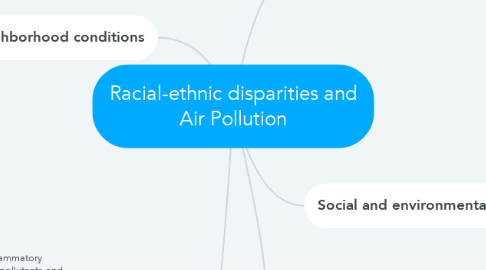Racial-ethnic disparities and Air Pollution
by Taylor Ray Kulp

1. Unequal air pollution burden across the United States
1.1. Despite decreases in air pollution concentrations in the United States over the last decade, racial-ethnic and socioeconomic disparities in air pollution exposure continue to persist. More than 40% of Americans presently reside in areas with high pollutant concentrations.
2. Social and environmental factors
2.1. Social and environmental factors such as neighborhood environment, social cohesion, economic stability, and access to quality education and health care all play a role in prevalence of disease among people of color and the poor.
3. Neighborhood conditions
3.1. Due to the social constructs in underserved populations, the burden of air pollution is greater, contributing to a higher rate of the development of chronic inflammatory conditions like asthma, putting these populations at a greater risk for severe consequences of an infection like COVID-19.
3.2. "Neighborhoods with higher percentages of people of color face, on average, double the rate of pollution-related childhood asthma compared to predominantly white neighborhoods." (George Washington University, 2021)
3.3. "Policies such as exclusionary zoning laws, restricted covenants, and eminent domain dictate where low- income housing projects are built, and where high- pollutant sources such as toxic waste disposal sites, bus depots, and waste transfer stations are placed within a region." (Cook et al., 2021)
4. Childhood asthma
4.1. Neighborhoods with a greater population of people of color have double the rate of pollution-related childhood asthma than those that don’t, putting these populations at extreme vulnerability.
5. COVID-19 severity
5.1. One source examines the inflammatory response in patients from air pollutants and the inflammatory response seen in patients with COVID-19, discovering that it was identical, further suggesting how air pollution may contribute to underlying health conditions and severe COVID-19 infections.


